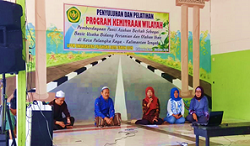Pemberdayaan Panti Asuhan Berkah Palangka Raya sebagai Basis Usaha Olahan Ikan di Kota Palangka Raya Kalimantan Tengah Empowerment of the Berkah Palangka Raya Orphanage as a Fish Processing Business Base in Palangka Raya, Central Kalimantan
Main Article Content
Abstract
The Berkah Palangka Raya Orphanage is located on Jalan G. Obos Induk, Menteng, Jekan Raya. Students are directed to activities that can become provisions when they graduate from school and enter the community by introducing making processed fish nuggets, meatballs, and catfish sempol. The purpose of the activity is to improve the skills of the orphanage in making processed fish and to train entrepreneurship in processed fish. The action was carried out from August to November 2019. The method of activity was socialization, counseling, training, and fish processing. The questionnaire results before the activity showed that 40-90% of students were familiar with processed fish such as nuggets, sempol, and fish balls, but 90-100% did not know how to process them. After the activity, the questionnaire results showed that the orphanage already knew the ingredients for making and how to prepare nuggets, sempol, and fish balls. However, only 50-60% could correctly explain the stages of making nuggets, sempol, and fish balls. The most popular preparations are nuggets because they make it easy, practical, delicious, while others like fish balls because the taste is not much different from meatballs. As many as 90% of orphanage children are interested in entrepreneurship in the fish processing sector because they can make their own money and have a cooking hobby. It can be concluded that the orphanage children can make nuggets, sempol, and fish balls and give quite good results. Processed fish produced by orphanage children is quite tasty and in demand by consumers.
Downloads
Article Details
Authors who publish with this journal agree to the following terms:
- Any article on the copyright is retained by the author(s).
- Author grant the journal, right of first publication with the work simultaneously licensed under a Creative Commons Attribution License that allows others to share work with acknowledgment of the work authors and initial publications in this journal.
- Authors are able to enter into a separate, additional contractual arrangements for non-exclusive distribution of published articles of work (eg, post-institutional repository) or publish it in a book, with acknowledgment of its initial publication in this journal.
- Authors are permitted and encouraged to post their work online (e.g., in institutional repositories or on their websites) prior to and during the submission process, as can lead to productive exchanges, as well as earlier and greater citation of published work.
- The article and any associated published material is distributed under the Creative Commons Attribution-ShareAlike 4.0 International License
References
Badan Standarisasi Nasional. 2002. Standar Nasional Indonesia. 01-6638-2002. Nugget. Jakarta: Badan Standarisasi Nasional.
Cahyaningati, O., Sulisiyati, T.D. 2020. Pengaruh Penambahan Tepung Daun Kelor (Moringa oleifera Lamk) terhadap Kadar β-karoten dan Organoleptik Bakso Ikan Patin (Pangasius pangasius). JFMR (Journal of Fisheries and Marine Research). 4(3):345-351. http://dx.doi.org/10.21776/ub.jfmr.2020.004.03.5
Kusmiyati, K. 2012. Nutrisi di Awal Perkembangan. Jurnal Pijar MIPA. 7(1):1-42. http://dx.doi.org/10.29303/jpm.v7i1.86
Lubis, N., Mus, S., Sari, N.I. 2015. Quality Analysis of Catfish Fillet (Pangasuius hypophthalmus) Salted with Different Salt Levels During the Storage Room Temperature. Jurnal online mahasiswa Fakultas Perikanan dan Ilmu Kelautan Universitas Riau. 2(2):1-9.
Manurung, D.C., Pato, U., Rossi, E. 2017. Karakteristik Kimia Dan Mutu Sensori Bakso Ikan Patin Dengan Penggunaan Tepung Bonggol Pisang Dan Tapioka. Jurnal online mahasiswa Fakultas Perikanan dan Ilmu Kelautan Universitas Riau. 4(1):1-15.
Munandar, D. 2017. Kajian penambahan Tepung Tapioka dengan tepung Terigu Terhadap mutu Kimia Bakso Ikan Lele (Clarias batrachus). Skripsi. Palangka Raya: Universitas Palangka Raya
Putra, T.R.P. 2013. Pengaruh Lama Penyimpanan Terhadap Mutu Nugget Ikan Toman (Channa micropeltes). Skripsi. Palangka Raya: Universitas Palangka Raya
Suhartini, S., Hidayat, N. 2005. Olahan Ikan Segar. Surabaya: Trubus Agrisarana.
Susanto, D. 2015. Pengaruh Penambahan Rumput Laut (Eucheuma cottonii) Dengan Prosentase yang Berbeda Terhadap Mutu Bakso Ikan Gabus (Channa striata). Skripsi. Palangka Raya: Universitas Palangka Raya
Sweking, S., Najamuddin, A., Aunurafik, A., Firlianty, F. 2019. Jenis dan Struktur Ukuran Ikan Yang Tertangkap di Danau Marang Kelurahan Marang Kecamatan Bukit Batu Kota Palangka Raya, Kalimantan Tengah. Agrikan: Jurnal Agribisnis Perikanan. 12(1):13-17. https://doi.org/10.29239/j.agrikan.12.1.13-17
Winarno, F.G. 1997. Kimia Pangan dan Gizi. Jakarta: Gramedia Pustaka Utama.
Wiranti, T. 2015. Pengaruh Proporsi Tapioka, Tepung Garut, Dan Daging Ikan Patin Terhadap Sifat Organoleptik Kerupuk. Jurnal Tata Boga. 4(1):28-36.
